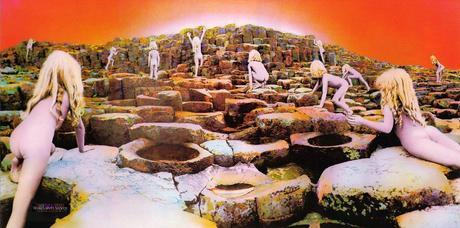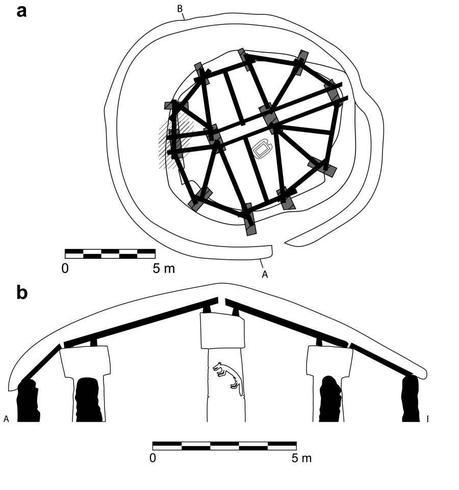In the series introduction, I asked whether Göbekli Tepe was (as the excavator Klaus Schmidt suggests) an archaeological or metaphorical Stairway to Heaven. Continuing the Led Zeppelin riff, a better question for today might be whether Göbekli’s megalithic structures were Houses of the Holy.

E.B. Banning suggests something along these lines in “So Fair a House: Göbekli Tepe and the Identification of Temples in the Pre-Pottery Neolithic of the Near East” (Current Anthropology 2011). Banning exhaustively reviews the Göbekli evidence and challenges the prevailing interpretation of the site. This is precisely what was needed and it shows archaeology working as a science.
In his very first site report from 1998, Schmidt had already concluded that Göbekli was a ritual center and claimed the “archaeological evidence is overwhelming, as the function of two partially excavated pillar buildings irrefutably prove.” As Banning’s article shows, the evidence is not overwhelming and the claims that have been made about Göbekli are refutable.
After surveying the evidence and claims made by Schmidt, offers an alternative view. It is a view informed by lessons learned from history and theory. The history comes from another famous Neolithic site, Çatalhöyük, which was first excavated in the 1960s by James Mellart. Mellart interpreted richly decorated structures as ritual “shrines” and claimed they were not residential. It was later found that the so-called “shrines” were in fact houses.
The theory comes from the ethnographically informed realization that binaries such as sacred/profane and secular/religious are post-Enlightenment Western constructs rather than human universals. By extension and association, this means that the ritual/domestic binary is either suspect or provincial. None of these binaries can be projected uncritically back in time and mapped onto 11,000 year old ruins. Historically situated and modern conceptions are not reliable guides to ancient cosmologies. And given what we know about most non-Western cosmologies, it seems unlikely that the Göbekli world was constructed or perceived through these binaries.
It is more likely that the sacred/profane existed on a continuum and were conjoined, as were ritual and domestic activities. With these things in mind, Banning observes: “The point is not that specialized shrines are incompatible with domestic ritual but that evidence for ritual or conspicuous symbolism does not automatically imply specialized temples.”
These salutary reminders out of the way, Banning turns to the nub of the Göbekli issue: “The question is whether the evidence justifies the site’s interpretation, as its excavator argues, as a hunter-gatherer cult center with no domestic occupation at all.” To answer it, Banning examines several aspects of the site: (a) the famous T-shaped pillars which Schmidt asserts were free-standing, open-air monoliths (similar to those at Stonehenge), (b) the supposed lack of evidence for household or domestic activities, (c) the alleged lack of access to water and (d) the ostensible absence of domesticated plants-animals.
For each, Banning points to contradictory evidence and suggests looking for additional corroborating or refuting evidence. In some cases this involves nothing more than looking at the existing evidence differently, more closely, or without preconceptions. In all cases, Banning finds the evidence or lack thereof equivocal.
If the Göbekli structures were in fact unroofed, it surely follows they were not houses. Beginning with a structural examination of the pillars, Banning suggests they are placed and buttressed in a manner that would have supported overhead wooden beams, which in turn would have been thatched. There are several hints (ranging from grooves and notches to wood) that this may in fact have been the case, and Banning has sketched one possible layout:

Aside from the structures themselves, the most remarkable feature of Göbekli is that it was discovered virtually intact. Fortuitously for archaeologists, Göbekli’s users (whether occupants or visitors) periodically filled earlier and older structures with surrounding debris and built on top of them. After its final use, the site was again filled. This explains why the site went unrecognized for so long; it looked like just another hill.
Banning is particularly interested in the huge amounts of fill material that were used and which he suspects was created on site as a result of occupation:
Notably, the site’s deep deposits also exhibit high densities of lithics—including a variety of points, scrapers, burins, and sickle blades—as well as evidence for “all stages of production.” One might expect to find stone tools related to the quarrying and manufacture of limestone monoliths and debris from the tools’ manufacture, but those in the fills, at least, are not noticeably different from what one might expect to find in a domestic deposit.
There is also abundant animal bone while dark earth found in the soil horizons may be anthropogenic, probably associated with the high density of bone fragments and other organic materials. Plant remains are not well preserved in these deposits but include a broad suite of edible wild seeds and the charcoal of trees such as ash, almond, poplar, and Brant’s oak that could have furnished both fuel and roof timbers.
In addition, Banning identifies possible hearths or hearth rings and mortars that would have been used to process grain. Some of these are bedrock mortars, which I happened to notice — near what appears to be a large cistern — in privately taken pictures of the site. The cistern is interesting because it speaks to the issue of water: Schmidt asserts that Göbekli had no easy or reliable access to this essential resource.
It would be unwise to assume that the lack of water at the site today is indicative of the situation 11,000 years ago:
[D]uring Göbekli Tepe’s occupation around 8000 cal BC, during the early Boreal period, the climate was considerably more humid than the current 450 mm of mean annual precipitation would suggest, and the water table was likely rather higher, potentially with springs closer to the site that no longer exist. Deforestation and modern irrigation projects have also had serious impacts on local water tables and streamflow, making the present distribution of water a poor indicator of Neolithic water sources.
Indeed, the many different kinds of (moisture-loving) plant remains found at the site suggest that water fell or flowed in amounts sufficient to nourish them.
In Schmidt’s estimation, these plant remains are — like the abundant animal remains — significant because they do not show signs of domestication. Aside from the difficulties of identifying domestication on the basis of morphology (with domesticated seeds being larger and domesticated animals smaller), Göbekli is a transitional Neolithic site. Hunting and gathering did not simply stop when people began planting seeds and controlling animals or domesticating them.
During this transitional period, plants and animals on the way to domestication may not look like their wild counterparts or may be “tweeners.” Of course some of these plants and animals were never domesticated; their presence is best explained by a mixed economy: there was some hunting and gathering of non-domesticates while at the same time others were being selected for domestication.
Where does this leave us? Banning has an idea and states it forcefully, though not in precisely this order:
While there is no doubt that Göbekli Tepe is an important site and that aspects of its structures were symbolically loaded, the claim that the site had no residential occupation is simply not credible.
Most likely, either the famous “temples” are actually houses or houses lie elsewhere on the site and are simply not represented or not yet identified in the excavated sample.
In short, there is no strong reason to assume that the people who used the buildings at GöbekliTepe, in any stratum, were not Neolithic villagers.
Ignoring even the possibility that some of the claimed shrines and temples at Neolithic sites may have been houses or other types of buildings, however, could distort our interpretations not only of Neolithic religion but of nonreligious aspects of the communities that inhabited or used those sites.
So fair a holy house indeed. In the next and final post in the Göbekli series, we will synthesize the materials from the previous ones and take stock of the whole.
Reference:
Banning, E.B. (2011). So Fair a House: Gobekli Tepe and the Identification of Temples in the Pre-Pottery Neolithic Current Anthropology, 52 (5), 619-660 : 10.1086/661207



